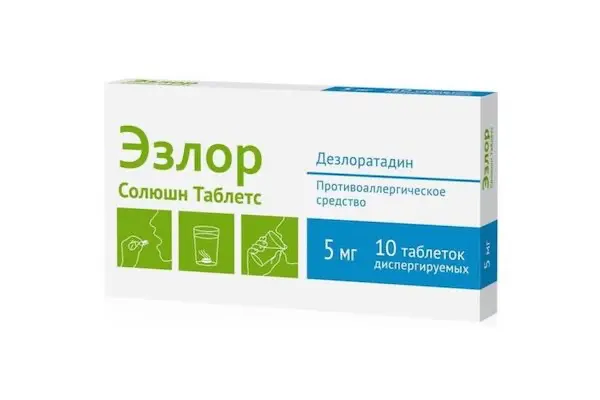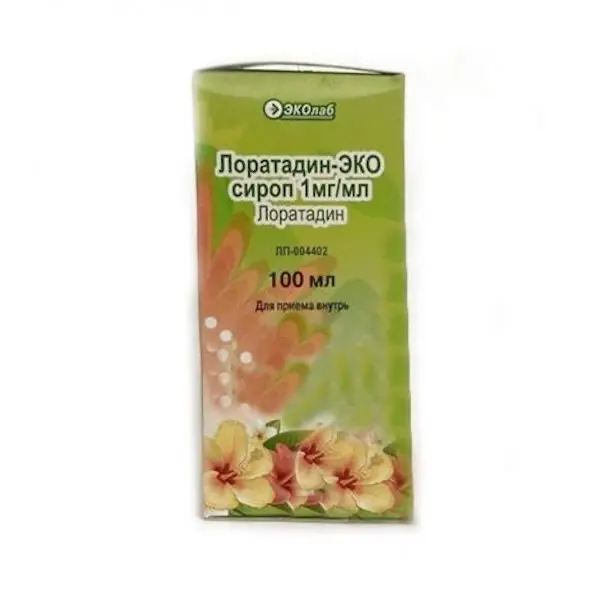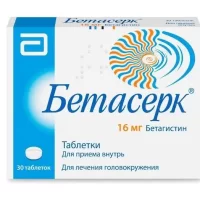Description
Desloratadine (Ezlor Solution) 5 mg Pharmacodynamics
H1-histamine receptor blocker (long-acting).
It is the primary active metabolite of loratadine. Inhibits the cascade of allergic inflammatory reactions, including release of anti-inflammatory cytokines, including interleukins IL-4, IL-6, IL-8, IL-13, release of pro-inflammatory chemokines (RANTES), Superoxide anion production by activated polymorphonuclear neutrophils, eosinophil adhesion and chemotaxis, release of adhesion molecules such as P-selectin, IgE-mediated release of histamine, prostaglandin D2 and leukotriene C4. Thus, it prevents and facilitates the development of allergic reactions, has antipruritic and antiexudative effects, reduces capillary permeability, prevents the development of tissue edema, spasm of smooth muscles.
The drug has no effect on the central nervous system, has practically no sedative effect (does not cause drowsiness) and does not affect the speed of psychomotor reactions. In clinical and pharmacological studies of desloratadine use in the recommended therapeutic dose, no prolongation of the QT interval on ECG was observed.
The action of the drug begins within 30 minutes after oral administration and lasts for 24 hours.
Indications
– Allergic rhinitis (reduction or relief of sneezing, nasal congestion, nasal mucus secretion, nasal itching, palate itching, itching and reddening of the eyes, lacrimation);
– Urticaria (reduction or elimination of skin itching, rash)
Contraindications
– Hypersensitivity to desloratadine, other components of the drug or to loratadine,
– Pregnancy and breast-feeding,
– Children under 1 year of age,
– phenylketonuria.
Caution:
Severe renal insufficiency, history of seizures.
Administration during pregnancy and breast-feeding:
The use of Desloratadine (Ezlor Solution) 5 mg in pregnancy is contraindicated due to the lack of clinical data on the safety of its use during pregnancy.
Desloratadine is excreted with breast milk, therefore it is contraindicated during breast-feeding.
Dosage and administration method
- Orally, regardless of the time of meals. The tablet should be dissolved in a small amount of water or apple juice (10-50 ml or 1/4 cup), before using the solution should be stirred.
- Adults and adolescents over 12 years of age – 1 tablet (5 mg) 1 time per day.
- Children 6 to 11 years of age – 1 tablet (2.5 mg) once a day.
- Children from 1 to 5 years of age take 1/2 tablet (1.25 mg – 1/2 tablet with dosage of 2.5 mg) once daily.
- In seasonal (intermittent) allergic rhinitis (with symptoms lasting less than 4 days per week or less than 4 weeks per year) it is necessary to evaluate the course of the disease. If the symptoms disappear, the drug should be discontinued, and if the symptoms reappear, the drug should be resumed.
- In case of year-round (persistent) allergic rhinitis (with symptoms lasting longer than 4 days per week or longer than 4 weeks per year), the drug should be taken for the entire period of allergen exposure
- To determine the duration of therapy with the drug, you should consult your physician.





